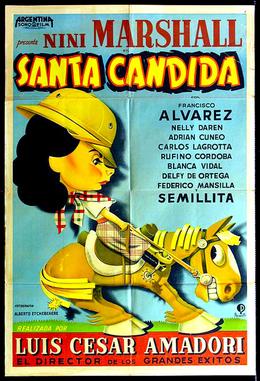
Julio Irigoyen was an Argentine film director notable for his work during the Golden Age of Argentine cinema.

Warly Ceriani was a classic Argentine actor who appeared in major Argentine films from 1938 to 1959.
Roberto Irigoyen was an Argentine cinematographer who worked in Argentine cinema between 1923 and 1948.

Uruguayan tango is a rhythm that has its roots in the poor areas of Montevideo around 1880. Then it was extended to other areas and countries. As Borges said: "...tango is African-Montevidean [Uruguayan], tango has black curls in its roots..." He quoted Rossi, that sustained that "...tango, that argentine people call argentine tango, is the son of the Montevidean milonga and the grandson of the habanera. It was born in the San Felipe Academy [Montevideo], a Montevidean warehouse used for public dances, among gangsters and black people; then it emigrated to underworld areas of Buenos Aires and fooled around in Palermo's rooms..." This also implies that different forms of dance were originated in the neighborhoods of Montevideo, Uruguay in the last part of the 19th century and in the early 20th century that was particular from that area and different from Buenos Aires. It consists of a variety of styles that developed in different regions of Argentina and Uruguay.

The Soul of the Accordion is a 1935 Argentine tango musical film from the Golden Age of Argentine cinema directed by Mario Soffici, who wrote it with José A. Bugliot. It is considered one of the earliest classics of Argentine cinema.
The Soul of a Tango is a 1945 Argentine musical film of the classical era of Argentine cinema, directed and written by Julio Irigoyen and starring Héctor Palacios, Elisa Labardén and Lea Conti. The film was part of the popular genre of tango films. It premiered on 20 April 1945.

Help Me to Live is a 1936 Argentine musical melodrama film directed and written by José A. Ferreyra with Libertad Lamarque. Starring Libertad Lamarque and Santiago Gómez Cou, the film premiered on 26 August 1936 in Buenos Aires. A typical tango-based film of the Golden Age of Argentine cinema, its international success gave a great boost to the booming Argentine film industry.

Ada Cornaro was a prominent Argentine film and theatre actress, tango dancer and singer of the 1930s and 1940s.

Canto de amor is a 1940 Argentine musical melodrama film of the Golden Age of Argentine cinema, directed and written by Julio Irigoyen. It is based on a tango with music by Osvaldo Fresedo. Carlitos Viván and Tino Tori, known for his comic Filomeno Chichipío persona, made appearances opposite Nelly Omar.

When the Heart Sings is a 1941 Argentine musical drama film of the Golden Age of Argentine cinema, directed by Richard Harlan and starring Hugo del Carril, Aída Luz and José Olarra. A man from a wealthy background meets and marries an actress despite fierce opposition from his family.
Los Peores del barrio is a 1955 Argentine film directed by Julio Saraceni.
Ritmo nuevo y vieja ola is a 1965 Argentine film directed by Enrique Carreras. It was written by Julio Porter. It premiered on 19 August 1965.

Gatica, el mono is a 1993 Argentine drama film directed by Leonardo Favio. It is a biopic of Argentine boxer José María Gatica.

Juan Carlos Copes was an Argentine tango dancer, choreographer, and performer. He started dancing with Maria Nieves when he was 17 and she 14, and the pair later married. Copes and Nieves played a leading role in the renaissance in Tango dancing from the 1970s and, particularly, in Argentine Tango following the 1983 restoration of democracy in that country. Copes was the first to create choreographed tango stage shows and also worked on seven films. Later in his career he partnered with his daughter, Johana, from his second marriage.

The National Autonomist Party was the ruling political party of Argentina from 1874 to 1916.

Tangos, the Exile of Gardel is an Argentine-French film released on 20 March 1986, directed by Fernando Solanas, starring Marie Laforêt, Miguel Ángel Solá and Philippe Leotard. The film was selected as the Argentine entry for the Best Foreign Language Film at the 59th Academy Awards, but was not accepted as a nominee.
Orquesta Francini-Pontier was an Orquesta típica formed in 1945 in Argentina by the violinist Enrique Mario Francini and the bandoneonist Armando Pontier. The orchestra played together until 1955 and was one of the leading tango orchestras of its day.

His Best Student is a 1944 Argentine biographical film of the classical period directed by Lucas Demare and starring Enrique Muiño and Ángel Magaña. It was released in Buenos Aires on 22 May 1944. The film won many awards, including the award for best film of the year.

Saint Candida is a 1945 Argentine comedy film of the classical era of Argentine cinema, directed by Luis César Amadori and starring Niní Marshall, Francisco Álvarez and Nelly Darén. The film's title is a reference to Candida the Elder. Delfy de Ortega won the Silver Condor Award for Best New Actress for her performance.

Su hermana menor is a 1943 Argentine romantic comedy film of the classical era of Argentine cinema, directed by Enrique Cahen Salaberry on his debut. It stars Silvia Legrand, Zully Moreno, Santiago Arrieta and Oscar Valicelli. The script was written by Carlos Adén.
This page is based on this
Wikipedia article Text is available under the
CC BY-SA 4.0 license; additional terms may apply.
Images, videos and audio are available under their respective licenses.














